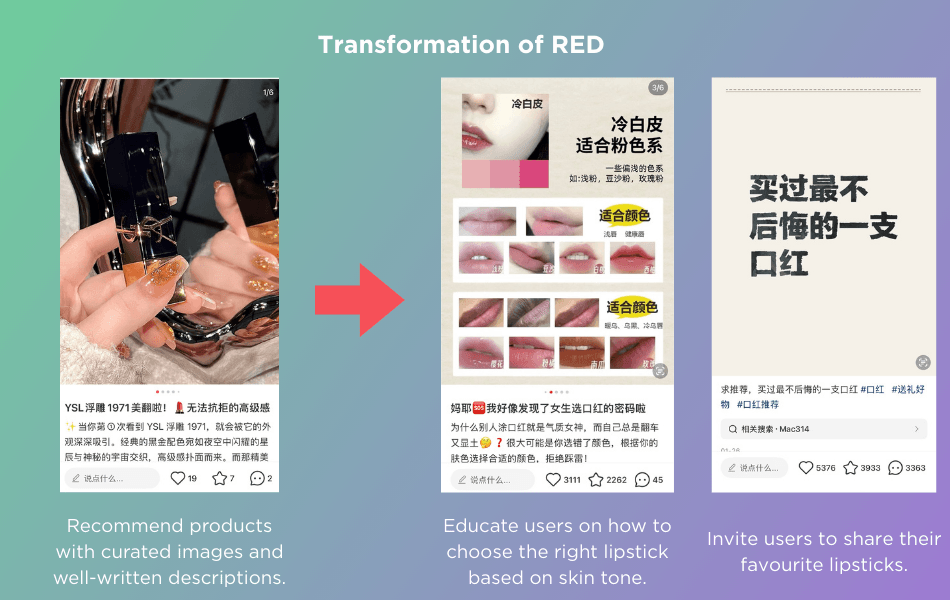Once known simply as a “shopping recommendation platform,” RED has undergone a quiet but powerful transformation. Initially built for “seed planting”, a term users coined for product discovery and sharing, RED is now more than just a platform to browse pretty things and follow influencer reviews, it’s becoming a search engine, a life handbook, and, most interestingly, a forum.
In this shift, avoidance of ads is growing. Instead of being charmed by polished language or influencer endorsements, users are now looking for sincerity: real stories, honest reviews, and in-depth, helpful content. In the age of content authenticity, the rules for brands have changed. To stay relevant, your marketing efforts must evolve.
RED’s Transformation: From Seed-Planting to Deep-Diving

1. Content Evolution
What used to be photo-heavy notes about skincare and fashion now includes long-form content packed with tips, personal experiences, and opinionated takes. This trend applies to other categories too. We’re seeing a rise in career discussions, study abroad guides, and exam preparation tips, all of which signal a growing demand for valuable and informative posts.
2. User Psychology Shift
This change isn’t just in content format, it’s rooted in how users perceive and interact with information on RED. The rise of “cautious browsing” (警惕性种草) reflects how users have become skeptical of overly polished posts. If something looks too curated, too perfect, or reads like an ad, it triggers suspicion. Instead of following influencers, users now look for verifiable facts like ingredient lists, product specs, side-by-side comparisons. Trust now comes from transparency, not aesthetics.
3. Platform Algorithm Evolution
RED now prioritises content that sparks genuine discussion, not just beautiful images and polished texts. Posts that generate high engagement, especially meaningful comments and debates, are more likely to be pushed to a wider audience.

The Challenge for Marketers: Ads Are Losing Power
The community has become adept at spotting “soft ads” – content that pretends to be a personal review but is actually sponsored. These posts are quickly dismissed or even criticised in the comments.
Also, RED’s algorithm is designed to limit the exposure of personal accounts that post too many commercial posts, for example, soft ads, frequent product placements or repetitive brand promotions. Content marked with the “sponsored ad” tag face reduced visibility, and even when it does reach users, they are still highly likely to be ignored and scrolled past.
RED’s users are no longer passive consumers, they’re smart, discerning, and vocal. For brands, this means it’s not enough to insert an ad inside a lifestyle photo.
How Brands Can Win: Content First, Trust Follows
So what’s the new game plan? Brands must rethink their presence on RED – not as advertisers, but as contributors to the community.
1. Build a Knowledge Hub
Rather than pushing products directly, brands should focus on building a library of informative content. For example, skincare brands explaining ingredient benefits or tech brands sharing setup guides. This type of content doesn’t just inform, it positions the brand as an expert that provides value to this community.
2. Join the Conversation
Good content isn’t a monologue, it’s part of a dialogue. Use question-based or opinionated titles that resonate with users:
“Why isn’t this toner working for sensitive skin?”
“What are the top tips for studying abroad?”
These types of posts feel like invitations to talk, instead of directly pushing a product, it is better to spark a discussion that relates to what you offer.
3. Empower Real Voices
The most convincing content comes from everyday users. Encourage KOCs (Key Opinion Consumers) and real customers to share their honest experiences. Let them use their own voice, their own photos, and even their own criticisms. Create an environment where “saying the truth” feels safe and welcome. In doing so, your brand will benefit from authentic exposure that’s far more credible than any ad campaign.

Final Thoughts: Be Useful, Not Just Visible
In this new era of RED, being trusted is far more important than being seen. The brands that will thrive aren’t the ones with the flashiest campaigns or biggest influencer budgets. They’re the ones that understand what users come to RED for.
If you are wondering how to get started, marketing experts at CHIN can help in tailoring your strategies and content to win on RED.

